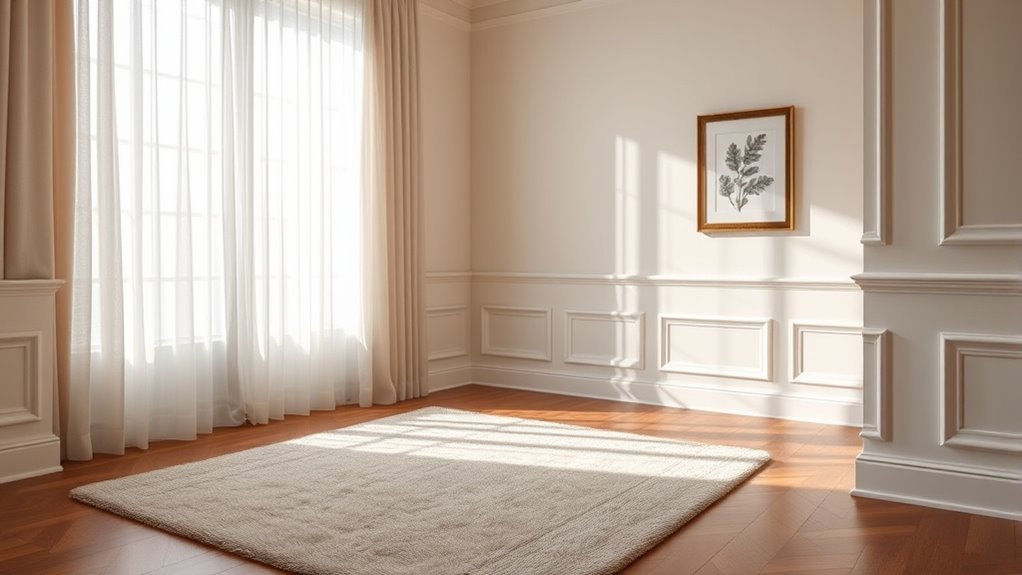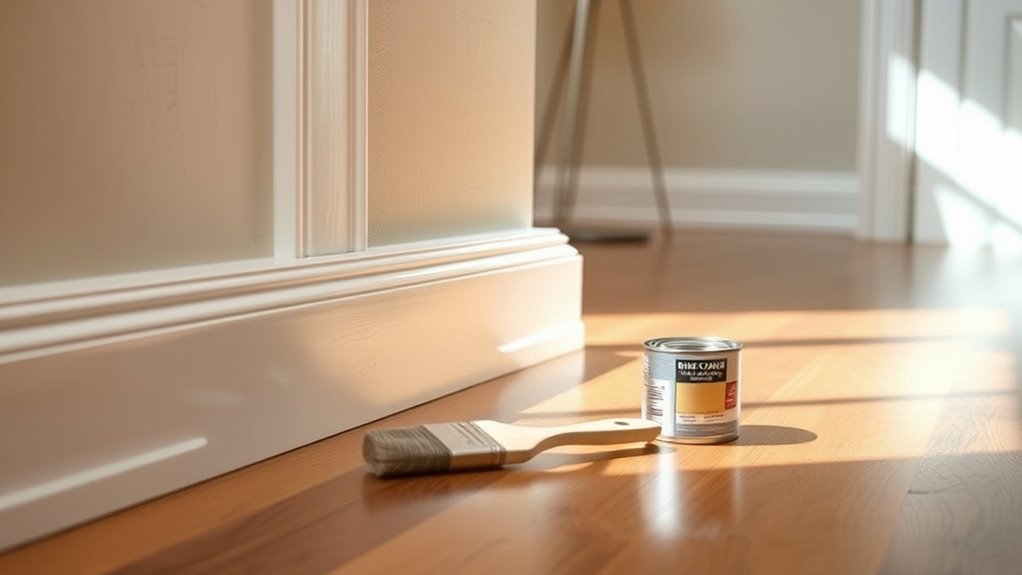Review of Top-Rated Baseboards
If you want baseboards that protect your walls and boost your room’s style, top-rated options like wood, MDF, and PVC offer durability and aesthetic appeal. Wood gives warmth, MDF is budget-friendly, and PVC handles moisture well. Easy installation and low maintenance matter too, and many users praise seamless finishes and lasting wear resistance. Choosing the right design to match your space is key. Keep exploring to find the perfect baseboard fit for your home’s look and life.
Benefits of Installing Quality Baseboards

While you might overlook them, quality baseboards play an essential role in both protecting your walls and enhancing your room’s overall appearance. When you invest in good baseboards, you’re not just adding a decorative touch; you’re boosting your space’s aesthetic appeal with clean lines and a polished finish. They create a seamless connection between your walls and flooring, giving your room a more refined, cohesive look. Beyond looks, quality baseboards also improve sound insulation, helping reduce noise transfer between rooms. This means you get more peace and quiet in your home, adding to your freedom to relax or focus without distractions. So, choosing the right baseboards is a smart move for both style and comfort in your living space.
Popular Materials for Baseboards
When choosing baseboards, you’ll find materials like wood, MDF, and PVC are common options. Each comes with its own pros and cons, especially regarding durability and upkeep. Understanding these differences will help you pick the best fit for your space and lifestyle.
Common Baseboard Materials
Choosing the right baseboard material can make a big difference in your room’s look and durability. You can pick from wood, MDF, PVC, or even metal—each offering unique baseboard styles that suit your vibe. Wood brings natural warmth and works well with classic or rustic designs, while MDF is budget-friendly and smooth, ideal if you want clean lines. PVC stands up to moisture, perfect for bathrooms or basements, and metal adds a modern, industrial edge. Your choice impacts installation techniques, too: wood might need nails and caulk, while PVC often uses adhesive or screws. Knowing these materials helps you match style with practicality, giving you the freedom to create a space that feels just right without compromising on function.
Pros and Cons
Each baseboard material comes with its own set of advantages and drawbacks that can affect your decision. For example, wood offers timeless baseboard styles and can be painted or stained to match evolving color trends, giving you creative freedom. However, it’s prone to dents and moisture damage. MDF is budget-friendly and smooth, making it easy to paint in any trendy hue, but it might not hold up well in humid spaces. PVC resists water and is low-maintenance, perfect if you want durability without sacrificing style, though it can look less natural. If you value versatility and freedom in design, weigh how each material’s pros and cons align with your taste and the look you want to achieve, especially considering how baseboard styles and color trends evolve over time.
Durability and Maintenance
Although baseboards add a finishing touch to your space, their durability and maintenance needs can vary widely depending on the material you choose. To guarantee your baseboard longevity, consider how each material holds up and what upkeep it demands. Here are some maintenance tips for popular baseboard materials:
- Wood: Offers classic beauty but needs regular sealing or painting to prevent damage.
- MDF: Affordable and smooth but can swell with moisture; repaint every few years.
- PVC: Waterproof and low-maintenance, perfect for humid areas.
- Metal: Extremely durable but might scratch; occasional polishing helps.
- Engineered wood: Balances durability and looks; wipe clean and touch up paint when needed.
Choose wisely to enjoy freedom from constant repairs and keep your baseboards looking fresh.
Top Baseboard Designs for Modern Homes
When you want to enhance the sleek look of your modern home, the right baseboard design can make all the difference. Modern styles focus on clean lines and subtle details, boosting your space’s aesthetic appeal without overwhelming it. You’ll find choices that blend simplicity with elegance, giving you the freedom to express your personal style effortlessly.
| Design Style | Key Feature |
|---|---|
| Minimalist | Straight edges |
| Contemporary | Smooth curves |
| Geometric | Angular shapes |
| Flat Stock | Simple and versatile |
Choosing any of these will elevate your interior, complementing your furniture and decor while keeping your home’s vibe fresh and open.
Durability and Maintenance Considerations

Selecting the perfect baseboard design is just one part of the equation; understanding how it holds up over time is equally important. You want baseboards that offer durability without demanding constant upkeep. Look for materials that excel in weather resistance and moisture control, especially if you live in humid or variable climates. Here’s what to take into account for lasting performance:
Durable, low-maintenance baseboards that resist moisture and weather keep your space looking great over time.
- Resistant to warping or cracking from moisture
- Easy to clean without special products
- Durable finishes that don’t chip or fade
- Materials that withstand temperature changes
- Low maintenance for freedom to enjoy your space
Choosing wisely means you won’t be tied down by repairs or replacements, letting your baseboards stay beautiful and functional for years without hassle.
Installation Tips for Baseboards
When installing baseboards, you’ll want to measure carefully and use precise cutting techniques to guarantee a perfect fit. Securing the boards properly and finishing the edges neatly will give your room a polished look. Let’s explore the best methods to make this process smooth and effective.
Measuring and Cutting Techniques
Although measuring and cutting baseboards might seem straightforward, getting precise dimensions is essential to guarantee a clean fit and professional look. To enjoy the freedom of a flawless installation, focus on these key points for measuring accuracy and cutting techniques:
- Always measure twice, cut once to avoid wasted material.
- Use a reliable tape measure and mark with a sharp pencil.
- Employ a miter saw for clean, angled cuts on corners.
- Cut baseboards slightly longer, then trim to fit perfectly.
- Double-check measurements against the wall before cutting.
Securing and Finishing Methods
There are several key methods you’ll want to use to secure and finish your baseboards properly to guarantee they stay put and look polished. Start with the right securing methods: use a nail gun or hammer with finishing nails to attach the baseboards firmly to the wall studs. If you want a cleaner look, consider adhesive along with nails for extra hold. When it comes to finishing techniques, caulk the seams and nail holes for a seamless appearance. Sand any rough edges lightly and apply paint or stain to match your room’s style. These steps give you the freedom to customize while ensuring durability, letting your baseboards enhance your space without hassle or frequent maintenance. Follow these tips, and your baseboards will look flawless and stay secure for years.
Cost Comparison of Leading Baseboard Brands

Several factors influence the cost of baseboards, and knowing what different brands charge can help you make a smarter purchase. When you explore brand comparisons and price analysis, you’ll see prices vary based on material, design, and durability. Here’s a quick cost overview to guide your freedom to choose:
- MDF Baseboards: Budget-friendly, usually $0.70–$1.50 per linear foot
- Wood Baseboards: Mid-range, typically $1.50–$4.00 per linear foot
- PVC Baseboards: Affordable and moisture-resistant, around $1.00–$3.00 per linear foot
- Polystyrene Baseboards: Cost-effective, about $1.00–$2.50 per linear foot
- High-End Hardwood: Premium choice, $4.00+ per linear foot
This price analysis empowers you to pick a baseboard brand that balances cost with the style and durability you want.
Customer Reviews and Ratings Analysis
Understanding the cost differences among baseboard materials is helpful, but seeing how real customers feel about these options can give you a clearer picture. When you explore customer reviews and ratings, you’ll notice that customer satisfaction often hinges on product longevity and ease of installation. Many users praise baseboards that stand up to wear and tear without warping or chipping, giving them freedom from constant repairs. You want baseboards that not only look great but also last, so checking feedback on durability is key. Pay attention to reviewers who mention how the product holds up over time in different environments. This insight helps you choose baseboards that fit your lifestyle, ensuring you invest in quality that keeps your space looking sharp for years.
Frequently Asked Questions
Can Baseboards Help With Soundproofing a Room?
You’re wondering if baseboards can help with soundproofing a room. While baseboards alone aren’t the strongest option for sound insulation, they can contribute when combined with other acoustic materials. Think of them as part of a bigger strategy to keep noise at bay, sealing gaps where sound sneaks through. If you want real freedom from noise, pairing baseboards with specialized acoustic treatments will give you a quieter, more peaceful space.
Are Baseboards Compatible With Radiant Floor Heating Systems?
Imagine warmth rising gently like a soft sunrise beneath your feet. When it comes to radiant heat compatibility, you’ll find that baseboard materials like wood or MDF usually play well with radiant floor heating systems, but metal ones might conduct heat differently. You want to choose materials that won’t trap heat, giving you the freedom to enjoy cozy floors without sacrificing style or safety. So yes, with the right baseboards, you’re all set!
Do Baseboards Require Special Tools for Cutting Inside Corners?
You don’t necessarily need special tools for cutting inside corners of baseboards, but mastering cutting techniques definitely helps. Using a miter saw or coping saw makes creating precise corner joints much easier and cleaner. If you want freedom in your projects, learning to cut at accurate angles and coping profiles lets you achieve seamless joints without relying on fancy gadgets. With some practice, you can confidently handle inside corners and make your baseboards look professional.
Can Baseboards Be Painted Over Existing Wallpaper?
Think of painting over wallpaper like trying to write a new story on an old, textured canvas. You can paint baseboards over existing wallpaper, but success depends on wallpaper types and the right painting techniques. Smooth, non-textured wallpaper holds paint better, while textured or peeling wallpaper might cause cracking. To keep your freedom to change styles, prep by cleaning and priming the surface well so your paint adheres smoothly and lasts longer.
How Do Baseboards Affect Home Resale Value?
When you choose baseboard styles that match current resale trends, you’re boosting your home’s appeal and value. Fresh, modern baseboards create a polished look buyers love, making your space feel well cared for and stylish. On the flip side, outdated or damaged baseboards can turn buyers off. So, picking the right style not only frees your design creativity but also helps you maximize your home’s resale potential effortlessly.






